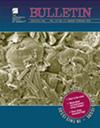帕米尔高原东部从中新世晚期到现在的同步延伸和收缩:从整个穆兹塔加塔穹隆南部的热时学数据反演中获得的启示
IF 3.7
1区 地球科学
Q1 GEOSCIENCES, MULTIDISCIPLINARY
引用次数: 0
摘要
晚新生代片麻岩穹丘覆盖了印度-亚洲碰撞带西北端的帕米尔突出部 30% 的地表。帕米尔高原的最高峰位于东部,长达 250 千米、呈南北走向的孔古尔山伸展系统控制着这里的地形。我们将 18 个样本中 115 个新的磷灰石(U-Th-Sm)/He 和锆石(U-Th)/He 单颗粒日期以及之前的热时学数据与三维热运动模型相结合,对帕米尔东部最大的片麻岩穹隆之一--穆兹塔格哈塔穹隆南部的热构造历史进行了约束。穆兹塔格哈塔穹隆南部西部边界的新冷却日期一般随着与孔古尔山南部断层距离的增加而增加,与过去 6.5 米年中沿近地表断层的正断层有关。建模结果表明,这种模式很可能是在过去 7 米年中,在一个平坦的斜坡-平坦的推力断层上的隆起和侵蚀的结果。建模并没有解决地形变化如何影响所观测到的冷却日期分布的问题,但它表明了与地形起伏增加有关的较快的推力滑动速度和与稳定地形有关的较慢的推力滑动速度。我们的研究结果表明,沿穆兹塔加塔穹隆南部的现代地形与帕米尔突出部东部的其他地区相似,是由浅层的正断层形成的,但其增长可能仍受深部收缩和地壳增厚的影响。本文章由计算机程序翻译,如有差异,请以英文原文为准。
Late Miocene to present synchronous extension and contraction in the eastern Pamir: Insights from inversion of thermochronologic data across the southern Muztaghata dome
Late Cenozoic gneiss domes cover ∼30% of the surface of the Pamir salient in the northwestern end of the India−Asia collision zone. The highest peaks of the Pamir are in the east, where the ∼250-km-long, ∼N−S-trending Kongur Shan extensional system controls the topography. We combined 115 new apatite (U-Th-Sm)/He and zircon (U-Th)/He single-grain dates from 18 samples and previous thermochronologic data with three-dimensional thermokinematic models to constrain the thermo-tectonic history of the southern portion of the Muztaghata dome, one of the largest gneiss domes in the eastern Pamir. The new cooling dates from the western boundary of the southern Muztaghata dome generally increase with distance from the southern Kongur Shan fault and are related to normal faulting along the fault at near-surface levels over the last 6.5 m.y. The new dates across the central−eastern portion of the dome outline the previously recorded U-shaped date pattern at a higher spatial resolution. The modeling indicates that this pattern is most likely the result of uplift and erosion above a flat-ramp-flat thrust fault at depth over the last 7 m.y. Modeling does not resolve how topographic changes may have affected the observed distribution of cooling dates, but it indicates a faster thrust-slip rate associated with an increase in relief and a slower one associated with steady-state topography. Our results suggest that the modern topography along the southern Muztaghata dome, similar to the rest of the eastern Pamir salient, is shaped by normal faulting at shallow depth, but its growth may still be governed by contraction and crustal thickening at depth.
求助全文
通过发布文献求助,成功后即可免费获取论文全文。
去求助
来源期刊

Geological Society of America Bulletin
地学-地球科学综合
CiteScore
9.30
自引率
8.20%
发文量
159
审稿时长
4-8 weeks
期刊介绍:
The GSA Bulletin is the Society''s premier scholarly journal, published continuously since 1890. Its first editor was William John (WJ) McGee, who was responsible for establishing much of its original style and format. Fully refereed, each bimonthly issue includes 16-20 papers focusing on the most definitive, timely, and classic-style research in all earth-science disciplines. The Bulletin welcomes most contributions that are data-rich, mature studies of broad interest (i.e., of interest to more than one sub-discipline of earth science) and of lasting, archival quality. These include (but are not limited to) studies related to tectonics, structural geology, geochemistry, geophysics, hydrogeology, marine geology, paleoclimatology, planetary geology, quaternary geology/geomorphology, sedimentary geology, stratigraphy, and volcanology. The journal is committed to further developing both the scope of its content and its international profile so that it publishes the most current earth science research that will be of wide interest to geoscientists.
 求助内容:
求助内容: 应助结果提醒方式:
应助结果提醒方式:


